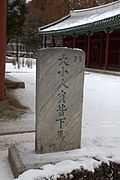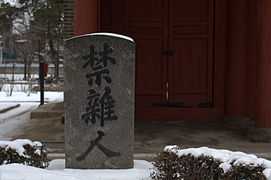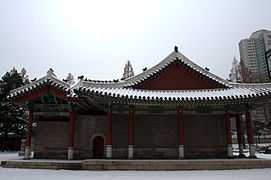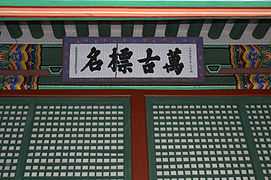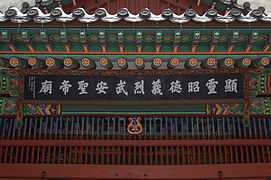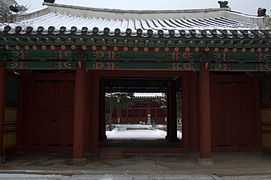Dongmyo
| Dongmyo | |
| Hangul | 동관왕묘 |
|---|---|
| Hanja | 東關王廟 |
| Revised Romanization | Donggwan-wangmyo |
| McCune–Reischauer | Tonggwanwangmyo |
Dongmyo (which literally means "Eastern Shrine") is shrine in metropolitan Seoul built in honour of 3rd century Chinese military commander, Guan Yu.
The Joseon government embarked on construction in 1599 and completed the work in 1601. The Wanli Emperor of Ming provided funds for construction of shrine, along with plaque with his own calligraphy. Three shrines - Dongmyo (east shrine), Seomyo (west shrine) and Bungmyo (north shrine) - were actually constructed in 1601. However, only Dongmyo Shrine remains today.
There was no such practice as worshipping Guan Yu as deity in Korea until Ming Dynasty military officers brought custom during military campaigns against Japan. As Neo-Confucian fundamentalists, Korean officers found it unacceptable to worship Guan Yu, but were unable to refuse Chinese request for enshrinement. The construction was burden to exhausted postwar Korea and shrine was maintained only with concern for relationship with China.
Koreans remained indifferent toward these shrines for long time. But during reign of King Yeongjo (1724-1776), Dongmyo and Nammyo (another shrine constructed by Ming military official Zhen Yin) were incorporated into state rituals for purpose of Ming worship linked with hostility toward and contempt for Manchu Qing Dynasty.[1]
The shrine is surrounded by wall of stone and mud, and covers area of 9,315 m². Ceremonies held here for many years to thank Guan Yu for divine support. Shrine compound enclosed on all sides by walls. Two figures to rear of compound are general while other figures are images of retainers and other generals. Figure with red face is general's earthly countenance and one with yellow face, his spirit.
The shrine, following Chinese model, is narrower in width than depth, and rear and side walls are sumptuously decorated with bricks. Inside main shrine wooden image of Guan Yu is enshrined, along with statues of four of his retainers.
A nearby station on Line 1 and Line 6 of the Seoul Subway is named after shrine. The shrine is located in Jongno-gu.
Gallery
Notes
- ↑ Kuwano Eiji 桑野栄治, Chōsen Shōchūka ishiki no keisei to tenkai 朝鮮小中華意識の形成と展開, Kokka rinen to taigai ninshiki 国家理念と対外認識, pp. 149-185, 2001.
References
- Kuwano Eiji 桑野栄治, Chōsen kōki ni okeru kokka saishi girei no hendō 朝鮮後期における国家祭祀儀礼の変動, Kurume Daigaku Kiyō: Kokusai Bunka gakka hen 久留米大学文学部紀要 国際文化学科編, Vol. 23, pp. 31-53. 2006.
See also
| ||||||
